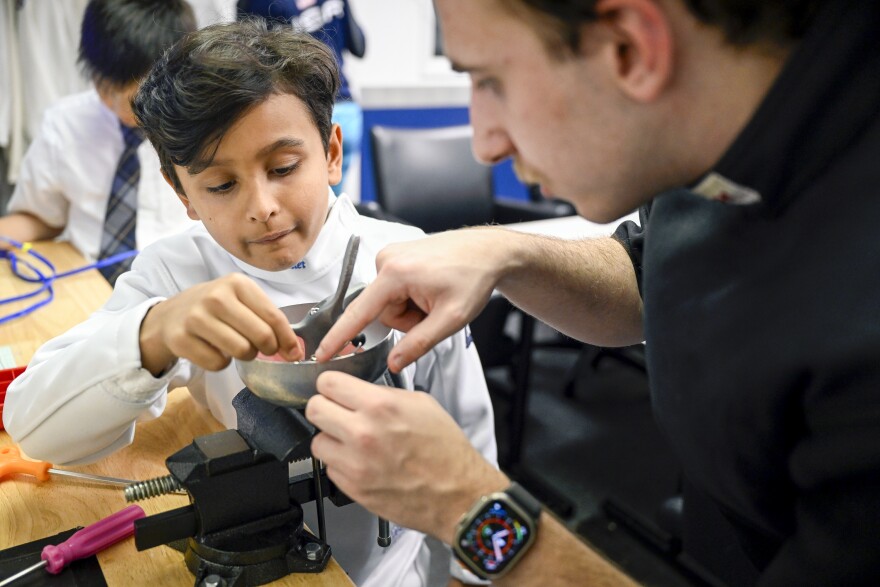Sebastian Cavallaro, a 10 year-old boy from Woodbridge, has fought his way onto the national fencing scene after first jumping into the sport last year.
Sebastian’s coach, Sandra Marchant, watched on as he got ready to face off against an adult at the Rogue Fencing Academy in Woodbridge.
But it's not like the movies, where swashbucklers have only their swords and wits to guide them in duels. Fencers fight with the help of a scoreboard and a sensor located at the tip of a sword, known in fencing as a blade.
Marchant showed off a cable plugged into the base of Sebastian’s blade and connected it to the scoreboard. He’s still a kid, but he’s getting really good at it, she says.
“He holds his own with all these guys,” Marchant said.
It’s really impressive, considering Sebastian just started fencing in 2022 but is already competing at national competitions.
There are other children his age and older, Marchant said, eager to try it out. Families are so interested in fencing, that she’s already looking into moving to a larger space to accommodate more students.

Marchant said the sport is getting more popular. And while fencing lags behind other sports such as baseball and football, Connecticut, she said, has a growing fencing scene.
Marchant said there’s a simple reason why fencing is getting a boost
“We get to hit our friends. This is so cool,” she said.
Sebastian likes to fence because it makes him think.
“My favorite part is probably fencing other people. Because I think about strategy and how to win,” he said.
Marchant has to make sure the blade actually works before anyone starts swinging. Fencing once worked on a honor system. But, people cheated, and players started wearing white, so blades marked with red chalk or ink could leave a mark on their opponent’s uniform to reflect the touch.
The sensor starts beeping and Sebastian is soon lunging at his contender, thrusting his epee blade. It is one of three blades used in fencing.
Sebastian started fencing partly because his friends also picked up the sport.

He said carrying the blade was physically taxing when he first started.
“It was a little heavy for me, because I wasn't used to carrying something of that weight for long periods of time,” he said.
He now practices six hours a week.
He’s a relative newcomer, but Sebastian has already competed in national events. This year he competed at the USA Fencing Youth 10 Men’s Epee, where he placed 53rd out of 95 athletes. He’s also competed at the Mission Super Youth Circuit and the Cobra Challenge Super Youth Circuit among competitions.

Fencing is a very inclusive sport. Jonah Cohen, an 11 year-old boy who uses a wheelchair, likes the sport because it helps him defend himself.
“The instincts that you develop are amazing. I parry when I don't even have to, but I just feel threatened,” Cohen said.
Cohen can still stand and walk. Marchant said she doesn’t treat him differently from the other students.
Sebastian sparred with children his age but later started to spar with teens and adults. But the class is mostly made up of children.
There’s a good reason for this. Fencing gives children more scholarship opportunities, according to Rob Holub, a sports management professor at the University of New Haven,

Holub noted while the sport isn’t that popular on a national level, saying that out of 520,000 NCAA athletes, 1,454 are fencers, the lack of students practicing it is actually a blessing in disguise.
It helps prospective students stand out from the rest.
“It is the best chance at an athletic scholarship at the Division I level, simply because of the number of players in total, compared to the amount of college spots available,” Holub said.
Marchant said many parents want their children to fence in order to improve their chances of getting admitted into prestigious universities.
Sebastian’s father, Chris, is more interested in building his son’s character.
He sat comfortably in a chair as he watched Sebastian swing his blade. Sebastian used to be a competitive skateboarder, and his father said his reaction is the same when he loses a match. He gets angry. Chris Cavallaro readily admits Sebastian hates to lose.
But there’s value in losing as well, he said.
“I'm hoping that through the sport and through his focus on improvement, and dedication that he finds the success and the strength from coming out of those defeats to build his character and strength,” Cavallaro said.






